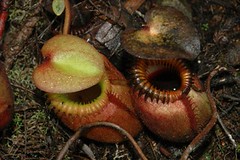Nepenthes villosa, Mt Kinabalu
I remember being very excited when, during my undergrad days, I learnt that there are actually pitcher plants in Singapore. Whats more exciting is that they were just a 15 minutes walk away from where Science Faculty was! The idea of actually seeing these carnivorous plants in person, touching them and peering at their contents sounded too good to be true. Did a few exploratory treks up Kent Ridge to hunt for the pitchers but to no avail until one fine day, they just appeared magically before my eyes. I had finally learnt how to pick them out amongst many plants clambering for sunlight in the undergrowth. I had acquired the eye.
That was the beginning of a love affair about 8 years ago (goodness how time flies). Now I enjoy pointing out pitchers whenever the opportunity arose to my friends and students. This is one plant which never fails to incite excitment and fascination and is a marvellous tool to illustrate how complex plants can be; for what appears to be an elaborate cup is actually a modification of the mid rib of the pitcher's leaf. The cup, complete with a lid, operculum and sometimes digestive fluid, is simply an extension of the leaf's primary function: which is to get more nutrients.
So naturally, when I went trekking in Kinabalu, I was eagerly waiting to see the largest pitcher plant in the world, the Nepenthes raja. As luck would have it, the plant was not found along the trail I was in. Instead, I saw N. villosa, an endemic found only in Mount Kinabalu.
It's good enough for now. I will go back some day.
That was the beginning of a love affair about 8 years ago (goodness how time flies). Now I enjoy pointing out pitchers whenever the opportunity arose to my friends and students. This is one plant which never fails to incite excitment and fascination and is a marvellous tool to illustrate how complex plants can be; for what appears to be an elaborate cup is actually a modification of the mid rib of the pitcher's leaf. The cup, complete with a lid, operculum and sometimes digestive fluid, is simply an extension of the leaf's primary function: which is to get more nutrients.
So naturally, when I went trekking in Kinabalu, I was eagerly waiting to see the largest pitcher plant in the world, the Nepenthes raja. As luck would have it, the plant was not found along the trail I was in. Instead, I saw N. villosa, an endemic found only in Mount Kinabalu.
It's good enough for now. I will go back some day.


0 Comments:
Post a Comment
<< Home